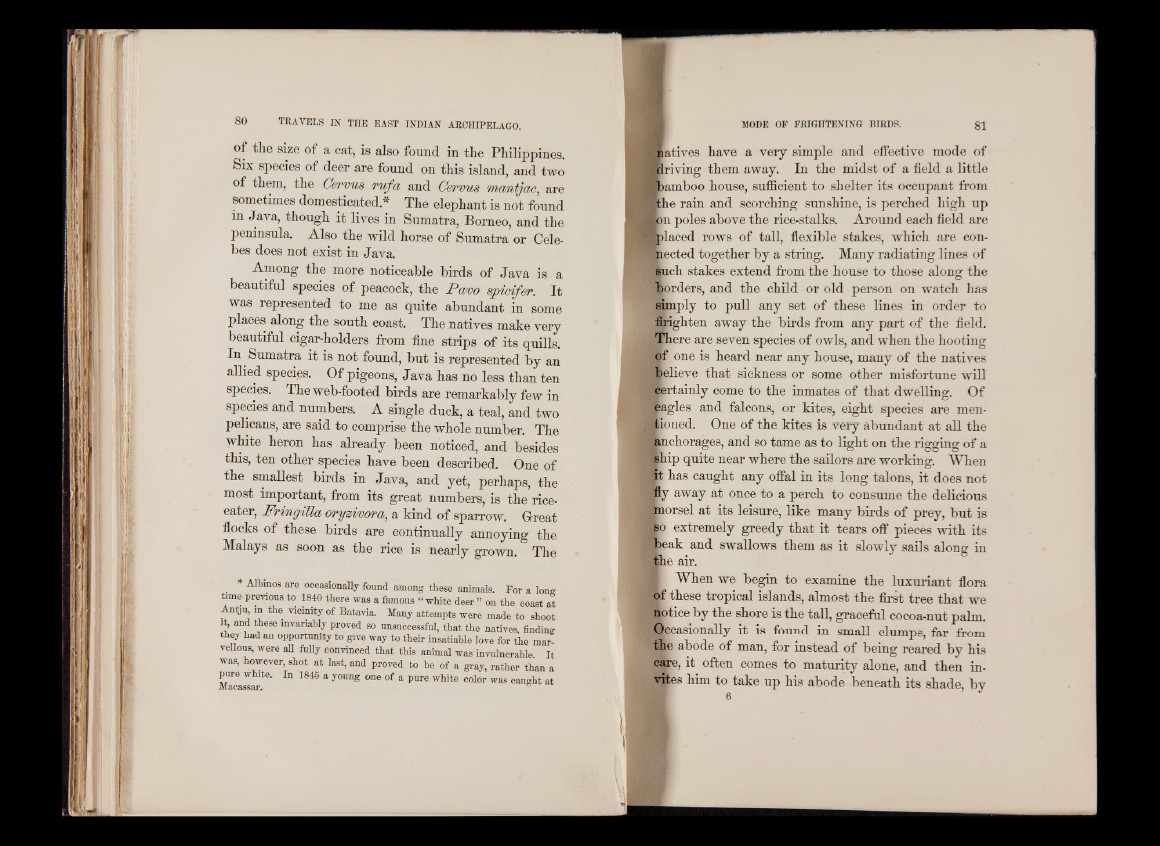
of tlie size of a cat, is also found in tlie Philippines.
Six species of deer are found on this island, and two
of them, the Oervus rufa and Oervus ma/ni/jac, are
sometimes domesticated* The elephant is not found
in Java, though it lives in Sumatra, Borneo, and the
peninsula. Also the wild horse of Sumatra or Celebes
does not exist in Java.
Among the more noticeable birds of Java is a
beautiful species of peacock, the Pamo spicifer. It
was represented to me as quite abundant in some
places along the south coast. The natives make very
beautiful cigar-holders from fine strips of its quills.
In Sumatra it is not found, but is represented by an
allied species. Of pigeons, Java has no less than ten
species. The web-footed birds are remarkably few in
species and numbers. A single duck, a teal, and two
pelicans, are said to comprise the whole number. The
white heron has already been noticed, and besides
this, ten other species have been described. One of
the smallest birds in Java, and yet, perhaps, the
most important, from its great numbers, is the rice-
eater, Fringilla oryzi/oora, a kind of sparrow. Great
flocks of these birds are continually annoying the
Malays as soon as the rice is nearly grown. The
. * Albmos are occasionally fonnd among these animals. For a lone
time previous to 1840 there -was a famous “ white deer” on the coast at
Antju in the vicinity of Batavia. Many attempts were made to shoot
■ H *7ese mvariably proved so unsuccessful, that the natives, finding
they had an opportunity to give way to their insatiable love for the marvellous,
were all fully convinced that this animal was invulnerable It
was, however, shot at last, and proved to he of a gray, rather than a
pure white. In 1845 a young one of a pure white color was caught at
natives have a very simple and effective mode of
plriving them away. In the midst of a field a little
¡¡bamboo house, sufficient to shelter its occupant from
■the rain and scorching sunshine, is perched high up
ion poles above the rice-stalks. Around each field are
■placed rows of tall, flexible stakes, which are connected
together by a string. Many radiating lines of
such stakes extend from the house to those along the
borders, and the child or old person on watch has
simply to pull any set of these lines in order to
firighten away the birds from any part of the field.
There are seven species of owls, and when the hooting
of one is heard near any house, many of the natives
believe that sickness or some other misfortune will
certainly come to the inmates of that dwelling. Of
Ragles and falcons, or kites, eight species are mentioned.
One of the kites is very abundant at all the
Anchorages, and so tame as to light on the rigging of a
ship quite near where the sailors are working. Wlien
it has caught any offal in its long talons, it does not
fly away at once to a perch to consume the delicious
morsel at its leisure, like many birds of prey, but is
jSo extremely greedy that it tears off pieces with its
Beak and swallows them as it slowly sails along in
the air.
When we begin to examine the luxuriant flora
of these tropical islands, almost the first tree that we
notice by the shore is the tall, graceful cocoa-nut palm.
Hbcasionally it is found m small clumps, far from
the abode of man, for instead of being reared by his
care, it often comes to maturity alone, and then in-
^Kes him to take up his abode beneath its shade, by